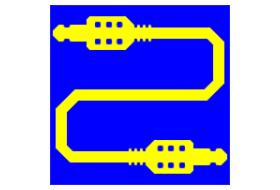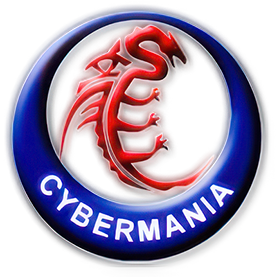
Virtual Audio Cable (VAC) is an audio bridge between applications that transmits sounds (audio streams) from app to app, from device to device.
VAC creates a set of virtual audio devices. Each device simulates an audio adapter (card) whose output is internally connected to the input, making a loopback. If an application plays audio to the output, the sound will not be audible because the signal is looped back to the input. But if another application records from the input, it receives the sound produced by the first app.
Such virtual devices are named Virtual Cables. The “Virtual Cable” term is used only in VAC description, as a placeholder. Actual device/endpoint names that you will see in applications’ windows, are different (for example, “Line 1”, “Line 2” etc.).
Each side of any Virtual Cable can be used by several apps at the same time. Sounds directed to the same playback endpoint are mixed. From the recording endpoint, each app gets its own copy of the sound.
VAC delivers audio signals completely inside the computer. No audio hardware is required. There is no quality loss (if no format conversion and/or volume control are involved). If all required conditions are met, audio transfer is bitperfect, suitable for audiophile applications. In well-tuned systems, signal latency is very low.
To transfer/route audio signals from an endpoint (device) to another, VAC offers Audio Repeater application.
Warning: in the Internet, there are several other products using the “Virtual Audio Cable” name. Some of them just use this name for promotional purposes, but some others are completely fake and contain malware. If you decide to try them, don’t forget to check their sites/binaries with anti-malware software/services.
Applicability
Use VAC with the following audio applications and application classes:
- Internet Telephony/VoIP/SIP/voice messengers (Skype, Discord, Ventrilo, MicroSIP).
- Live mixing/DJ (vMix, Mixxx, VirtualDJ, VoiceMeeter Banana/Potato).
- Live broadcasting (Open Broadcaster/OBS Studio, WireCast, VidBlasterX. SAM Broadcaster).
- Speech synthesis/recognition (Google Text-to-Speech/Speech-to-Text, Dragon Naturally Speaking).
- Software synthesizers and studio/DAW (Ableton, Acid, AudioMulch, Band-in-a-Box, Bidule, Cakewalk/Sonar, Cubase, FL Studio, GarageBand, Logic, MiniMoog, n-Track, Nuendo, Reaktor, REAPER, Reason, Samplitude, Traktor, Vegas).
- Audio editors/recorders (Audacity, Adobe Audition, GoldWave, WaveLab, Sound Forge).
- Virtual Machines (VMware Player/Workstation, VirtualBox, Hyper-V).
- Amateur and software-defined radio (Flex Radio, PowerSDR, HAM Radio Deluxe, HamSphere, HDSDR, Fldigi, SDR-Radio, WSJT-X, JTDX).
- Audio application development – watch the application’s audio operations, check audio data played, supply with specific data to be recorded etc.
Compatibility
VAC works in Windows XP, Vista, 7, 8, 8.1 and 10.
No obsessive activity
VAC just performs things what it is intended for: passes audio streams between applications, converting audio formats if necessary. It never guides you to advertising pages, nor pops up busily on the screen, nor installs hidden activities in your system. VAC does only actions that you explicitly demand for.
Older versions
VAC 4 works only under Windows versions starting from XP (5.1).
Version 4.70 (16.04.23)
- Added ARM64 binaries.
- Fixed a driver bug that caused render streams to speed up when volume control and/or format conversion are used.
- Fixed a driver bug that caused OF/UF values in the stream termination event to always be zero.
- Added client clock adjustment feature to the driver, allowing applications to adjust cable clock on the fly, without changing cable clock correction value permanently.
- Packet mode support is disabled by default to improve stream reliability in typical applications. Packet mode controls added to VAC Control Panel.
- Added a workaround for Windows bug that requires to start high-level clients before KS ones.
- Added the name of the process that created the stream to the stream information.
- Changed algorithm of actual sampling rate calculation for better reflection of recent changes.
- Added a dynamic cable clock adjustment to Audio Repeater applications.
- Changed layout of Audio Repeater KS window to fit low-height screens.
- Audio Repeater MME now finds the endpoint by name when the transfer is started. It allows to avoid restarting the app if endpoint order was changed (when audio devices are plugged/unplugged, default endpoint is changed etc.).
- Added workaround to Setup application to remove hidden “phantom” device instance if the previous installation was forcibly aborted.
- Setup application now searches for uninstallers of older versions.
- VAC driver API version increased to 6.
Fix little bug installation
(Retail Installer) x86 x64

2 thoughts on “Virtual Audio Cable 4.70”
nb
Something strange happened, during the installation a message appears that the url was not found or something like that and the installation does not complete. 4.70